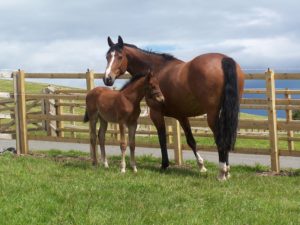Fencing Options for Equine Grazers
June 2, 2020
Rachel Annan, CAFRE Equine Technologist
Fencing of grazing areas for equines falls into two categories; boundary fencing to prevent animals leaving the grazing area and internal fencing which divides the grazing area into smaller sections to separate animals into specific groups. The fencing requirements for each of these roles are different and affect the fencing options available, although there are common factors that must be considered when selecting any fencing materials.
Factors for Consideration
Safety is the primary consideration when selecting fencing. Fencing materials must not pose a hazard to horses, or any other species that may also graze the area. Sharp edges, splintered wood and protruding nails are all hazards that can cause injury to horses or damage to rugs. The spaces between rails or wire strands must either be large enough to prevent limbs becoming trapped or small enough to prevent limbs passing through the fence. Fencing must also be robust enough to withstand horses rubbing, scratching or leaning on the fence.
The costs of erecting and maintaining fencing are also key factors when selecting a suitable fencing type. Wooden post and rail fencing is costly to construct due to high material costs and the amount of labour required to build the fence. Wooden fencing also requires annual treatment with preservative to maintain it in good working order. Electric tape is a cheaper fencing option requiring minimal maintenance although it should only be used as internal fencing. Keepsafe Horse Wire is specifically designed for use with horses and offers the durability of wooden fencing but requires considerably less maintenance.
Boundary Fencing
Post and Rail
Post and rail is thought to be the best fencing option due to being durable and aesthetically pleasing. The treated wood provides a strong boundary that lasts for many years if correctly maintained. To discourage horses from jumping the boundary fence the top rail should be a minimum of 4ft/1.2m high with rails positioned on the inside of the vertical posts to prevent them being dislodged when leant on by animals within the field. All boundary fencing should be checked on a daily basis to ensure animal safety and any repairs undertaken as soon as possible. Post and rail can be used in conjunction with hedgerows to provide shelter in addition to security.
Advantages:
- Strong and durable
- Safe (if maintained)
- Aesthetically pleasing
Disadvantages:
- Expensive to erect and repair
- Must be maintained
- Susceptible to wood chewing
Horse Wire
Keepsafe Horse Wire is a galvanised wire fencing incorporating a v-mesh design that is utilised at Enniskillen Campus, CAFRE. The fencing is constructed using treated wooden posts, with the base of the wire positioned close to the ground. The close proximately of the fence base to the ground makes the fencing extremely difficult for other animals to enter the field, which is particularly beneficial in areas where rabbits become problematic. The wire stands at 4ft/1.2m high making it ideal for boundary fencing. The cost of constructing a Keepsafe Horse Wire fence is marginally lower than using wooden post and rail however maintenance costs are considerably lower.
The v-shaped mesh prevents hooves and limbs passing through the fencing making it extremely safe and suitable for use with foals, youngstock and adult horses. The fencing is sturdy enough to withstand horses rubbing and the wire prevents wood chewing behaviour.
- Advantages:
- Strong and durable
- Safe (if maintained)
- Low maintenance
- Lower construction costs

Disadvantages:
- Less aesthetically pleasing
- Can be time consuming to construct
Internal Fencing
Electric Fencing
Electric fencing is ideal for internal fencing as it can easily be moved to suit the requirements of grazing horses. Electric fencing comes in wire, rope or tape form although the wire is best avoided for horses due to the low visibility and potential for injury. Plastic cable specifically designed for horses is now available on the market and is a safer alternative as it is less likely to cause injury, although all electric fencing must be kept taught to prevent sagging and horses becoming entangled. The effectiveness of the battery should also be tested regularly to deter horses from leaning and damaging the fencing.
- Advantages:
- Low cost
- Easy to construct
- Movable
- Prevents wood chewing
- Safe (if maintained)
Disadvantages:
- Not suitable for boundary fencing
- Less durable
